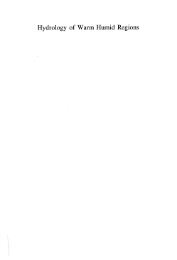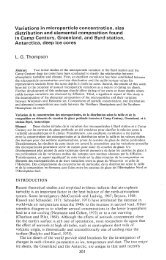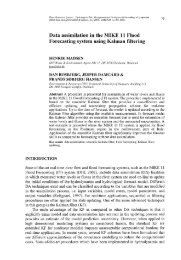A technique for the determination of areal average rainfall - IAHS
A technique for the determination of areal average rainfall - IAHS
A technique for the determination of areal average rainfall - IAHS
Create successful ePaper yourself
Turn your PDF publications into a flip-book with our unique Google optimized e-Paper software.
Hydrological Sciences-Bulletin-des Sciences Hydrologiques, 23, 4, 12/1978<br />
A <strong>technique</strong> <strong>for</strong> <strong>the</strong> <strong>determination</strong><br />
<strong>of</strong> <strong>areal</strong> <strong>average</strong> <strong>rainfall</strong><br />
PANDE, B. B. LAL and G. AL-MASHIDANI College <strong>of</strong> Engineering,<br />
University <strong>of</strong> Mosul, Mosul, Iraq<br />
Received 6 February 1978, revised 7 August 1978<br />
Abstract. A method was developed <strong>for</strong> allocating an area likely to be shared by a raingauge station.<br />
Average <strong>areal</strong> precipitation was found by weighting <strong>the</strong> <strong>rainfall</strong> at <strong>the</strong> gauging station in terms <strong>of</strong><br />
<strong>the</strong> product <strong>of</strong> distances enclosing it or radiating from it. The method was applied to two real and<br />
two hypo<strong>the</strong>tical basins and <strong>the</strong> results were compared with those obtained by existing <strong>technique</strong>s.<br />
Une méthode pour la détermination de précipitation moyenne pour une zone donnée<br />
Résumé. On a développé une méthode d'allouer une zone où on aménagera probablement une<br />
station de jaugeage. On a trouvé la précipitation moyenne pour la zone en calculant la précipitation<br />
à la station de jaugeage en fonction du produit des distances qui l'enferment ou qui y partent. On<br />
a appliqué la méthode à deux bassins réels et à deux bassins hypothétiques et on a comparé les<br />
résultats avec ceux qu'on a obtenus en utilisant des <strong>technique</strong>s actuelles.<br />
INTRODUCTION<br />
The usual <strong>technique</strong>s <strong>of</strong> determining <strong>average</strong> depth <strong>of</strong> <strong>rainfall</strong> over an area, viz. arithmetic<br />
mean, Thiessen polygon and isohyetal method, are well known. Some new<br />
methods have also been proposed in <strong>the</strong> literature. Akin (1971) developed <strong>the</strong> idea<br />
<strong>of</strong> dividing an area into triangles and wrote computer programs <strong>for</strong> <strong>the</strong> necessary<br />
calculations. Shaw & Lynn (1972) applied ma<strong>the</strong>matical surface fitting <strong>technique</strong>s.<br />
They used bi-cubic spline and multiquadric analysis <strong>technique</strong>s <strong>for</strong> computing <strong>average</strong><br />
<strong>rainfall</strong>. Hutchinson & Walley (1972) applied finite element <strong>technique</strong>s. Their method<br />
also took into account an accurate representation <strong>of</strong> <strong>the</strong> shape and relief <strong>of</strong> <strong>the</strong> basin.<br />
Bethlahmy (1976) developed a two-axis method. The method is simple and fast but<br />
has not been applied to a real basin. Fur<strong>the</strong>rmore <strong>the</strong>re is a considerable bias involved<br />
in determining <strong>the</strong> two axes. Ano<strong>the</strong>r serious limitation <strong>of</strong> <strong>the</strong> methodology is that<br />
a particular raingauge, however far outside <strong>the</strong> boundary <strong>of</strong> <strong>the</strong> basin, will still have<br />
some kind <strong>of</strong> effect in deciding <strong>average</strong> precipitation over <strong>the</strong> basin. Many such o<strong>the</strong>r<br />
methods have been developed and <strong>the</strong> existing ones computerized. Somehow even<br />
with all <strong>the</strong>se developments, a practising hydrologist still depends upon Thiessen polygons.<br />
The present paper suggests a method which is similar to <strong>the</strong> Thiessen method<br />
but easier to apply.<br />
0303-6936/78/1200-0445$02.00 © 1978 Blackwell Scientific Publications 445
446 Pande, B. B. Lai and G. Al-Mashidani<br />
PROPOSED METHOD<br />
The proposed method <strong>for</strong> determining <strong>areal</strong> <strong>average</strong> precipitation is based on three<br />
assumptions which are similar to those <strong>of</strong> Thiessen. (1) A raingauge is significant only<br />
up to <strong>the</strong> mid-distance towards ano<strong>the</strong>r raingauge. (2) A raingauge near <strong>the</strong> centre <strong>of</strong><br />
<strong>the</strong> area is more significant than one far removed from <strong>the</strong> centre. Those outside <strong>the</strong><br />
basin are not equally significant with respect to <strong>average</strong> <strong>rainfall</strong> over <strong>the</strong> area. (3) The<br />
significance <strong>of</strong> <strong>the</strong> raingauge is affected by <strong>the</strong> shape <strong>of</strong> <strong>the</strong> basin.<br />
With reference to Figs 1 and 2 <strong>the</strong> proposed method is illustrated in a stepwise<br />
manner as follows.<br />
(1) Join <strong>the</strong> adjoining raingauge stations by straight lines and establish <strong>the</strong> mid<br />
points <strong>of</strong> <strong>the</strong>se lines.<br />
(2) (a) If no central station is available, as in Fig. 1 establish <strong>the</strong> approximate<br />
FIG. 1. No central station is available<br />
geometric centre <strong>of</strong> <strong>the</strong> area by estimation, (b) Join <strong>the</strong> established centre point with<br />
points established in Step 1 and extend <strong>the</strong> resulting lines to <strong>the</strong> boundary <strong>of</strong> <strong>the</strong> basin.<br />
(3) (a) If a central station is available as in Fig. 2 join it to <strong>the</strong> various stations<br />
lying around it by straight lines and mark <strong>the</strong> mid points <strong>of</strong> <strong>the</strong> resulting lines, (b) Join<br />
<strong>the</strong>se mid points so as to <strong>for</strong>m a polygon around <strong>the</strong> central station, (c) Draw lines<br />
from <strong>the</strong> mid points <strong>of</strong> <strong>the</strong> sides <strong>of</strong> <strong>the</strong> polygon <strong>of</strong> Step 3b to <strong>the</strong> points established<br />
in Step 1 and extend <strong>the</strong>se lines to <strong>the</strong> boundary <strong>of</strong> <strong>the</strong> basin.<br />
°5<br />
FIG. 2. Central station is available
Determination <strong>of</strong><strong>areal</strong> <strong>average</strong> <strong>rainfall</strong> 447<br />
(4) Each <strong>of</strong> <strong>the</strong> raingauge stations is now enclosed by an area, <strong>the</strong> weight <strong>of</strong> which<br />
can be calculated as follows, (a) The central station weight is calculated as half <strong>the</strong> sum<br />
<strong>of</strong> <strong>the</strong> product <strong>of</strong> adjacent radial lines from <strong>the</strong> central station up to <strong>the</strong> enclosing<br />
polygon or up to <strong>the</strong> basin boundary whichever is less, (b) Weights <strong>for</strong> outer stations<br />
are obtained by <strong>the</strong> product <strong>of</strong> <strong>the</strong> length <strong>of</strong> adjacent lines, e.g. <strong>for</strong> station 2 <strong>of</strong> Fig. 1<br />
<strong>the</strong> weight is computed as Oa2 X Oa3 and <strong>for</strong> station 2 <strong>of</strong> Fig. 2, <strong>the</strong> weight is computed<br />
as 02a2 X 03a3.<br />
The <strong>average</strong> precipitation <strong>of</strong> <strong>the</strong> basin is <strong>the</strong>n calculated by summing <strong>the</strong> weighted<br />
precipitation and dividing this by <strong>the</strong> sum <strong>of</strong> weights. Thus <strong>for</strong> Fig. 1 with no central<br />
station:<br />
n —1<br />
S Pi w i + Pn Wn<br />
' =1<br />
where n — number <strong>of</strong> stations<br />
Pi — value <strong>of</strong> precipitation at station i<br />
wt = weight <strong>for</strong> station i = Oa{ X Oai+1<br />
wn — weight <strong>for</strong> <strong>the</strong> nth station<br />
= Oan X Oa1<br />
and <strong>for</strong> Fig. 2 with a central station<br />
V 1<br />
Pavg<br />
W, + W„<br />
j=l L PiWi+Pn^n+Pc<br />
£ Wi + wn+wc<br />
i=i<br />
where p = precipitation at station / or n or c according to <strong>the</strong> subscript<br />
wt = weight at station i<br />
= OpiX Oi+1ai+1<br />
wn = weight at «th station<br />
= Onan X Oxax<br />
n — total number <strong>of</strong> outer stations (five in <strong>the</strong> present case)<br />
wc = weight at <strong>the</strong> central station<br />
= Vz "£" (pbj X cb]+1) + (cbn X cbx)<br />
APPLICATION OF THE METHOD<br />
The method has been applied to some real and hypo<strong>the</strong>tical basins. Schulz (1973)<br />
considers <strong>the</strong> basin <strong>of</strong> Kings River above Piedra, Cali<strong>for</strong>nia (Fig. 3). Punmia et al.<br />
(1969) consider <strong>the</strong> Canvery River basin in India (Fig. 4). The present <strong>technique</strong> was<br />
applied to <strong>the</strong>se basins and <strong>the</strong> results were compared with <strong>the</strong> arithmetic mean,<br />
<strong>the</strong> Thiessen and <strong>the</strong> isohyetal methods as shown in Table 1. Details <strong>of</strong> computations<br />
are shown in Tables 3 and 4.<br />
Nemec (1973) considers a hypo<strong>the</strong>tical basin with all raingauges lying beyond its<br />
boundary as shown in Fig. 5. Bethlahmy (1976) also considers a hypo<strong>the</strong>tical basin
448 Pande, B. B. Led and G. Al-Mashidani<br />
Name <strong>of</strong><br />
basin<br />
G (2495)<br />
L (37.41 )
Name <strong>of</strong><br />
basin<br />
Nemec's basin<br />
Bethlahmy's basin<br />
Storm 1<br />
Storm 2<br />
Storm 3<br />
Storm 4<br />
Storm 5<br />
Determination <strong>of</strong> area! <strong>average</strong> <strong>rainfall</strong><br />
61 5mm<br />
FIG. 5. Nemec's hypo<strong>the</strong>tical basin.<br />
FIG. 6. Bethlahmy's hypo<strong>the</strong>tical basin.<br />
TABLE 2. Comparison <strong>of</strong> results <strong>for</strong> two hypo<strong>the</strong>tical basins<br />
Arithmetic<br />
mean<br />
(cm)<br />
66.8<br />
2.00<br />
2.00<br />
2.00<br />
2.00<br />
2.00<br />
Thiessen<br />
method<br />
(cm)<br />
66.0<br />
2.86<br />
2.01<br />
155<br />
1,76<br />
1.43<br />
Isohyetal<br />
method<br />
(cm)<br />
2.51<br />
1.84<br />
1.80<br />
1.76<br />
1.46<br />
Two-axis<br />
method<br />
(cm)<br />
2.38<br />
2.14<br />
1.81<br />
1.87<br />
1.80<br />
Present<br />
method<br />
(cm)<br />
66.9<br />
2.50<br />
1.90<br />
1.65<br />
1.62<br />
2.04
450 Pande, B. B. Lai and G. Al-Mashidani<br />
Name <strong>of</strong><br />
station<br />
A<br />
B<br />
C<br />
D<br />
E<br />
F<br />
G<br />
M<br />
J<br />
K<br />
L<br />
H<br />
I<br />
TABLE 3. Details <strong>of</strong> <strong>the</strong> calculations <strong>for</strong> <strong>the</strong> basin <strong>of</strong> Kings River above Piedra (Fig. 3)<br />
Total<br />
Rainfall<br />
(in)<br />
8.67<br />
17.81<br />
18.25<br />
17.67<br />
21.74<br />
23.71<br />
24.95<br />
15.05<br />
33.19<br />
35.53<br />
37.41<br />
34.28<br />
29.29<br />
Details <strong>of</strong> w;<br />
0.2 X 2.2<br />
2.2 X 1.15<br />
1.15 X 1.75<br />
Vi (Sum <strong>of</strong> <strong>the</strong> product <strong>of</strong><br />
radial distances from D)<br />
1.2 X 0.5 + 2.05 X 1.55<br />
3.25 X 1.2 + 2.1 X 2.05<br />
1.75 X 3.25<br />
0.2 X 0.65<br />
2.45 X 1.55<br />
0.85 X 2.45<br />
0.85 X 0.6<br />
0.6 X 2.1<br />
VÏ (Sum <strong>of</strong> <strong>the</strong> product <strong>of</strong><br />
radial distances from I)<br />
Wi<br />
0.44<br />
2.53<br />
2.0125<br />
14.55<br />
3.7775<br />
8.205<br />
5.6875<br />
0.13<br />
3.7975<br />
2.0825<br />
0.51<br />
1.26<br />
14.21<br />
59.19375<br />
Pi w i<br />
3.814<br />
45.059<br />
36.7281<br />
257.01<br />
82.1228<br />
194.54<br />
141.9031<br />
1.9565<br />
126.039<br />
73.99<br />
19.0791<br />
43.1928<br />
416.3939<br />
1441.8286<br />
Sum <strong>of</strong> <strong>the</strong> product <strong>of</strong> radial distances from D<br />
= 1.4 X 2.4 + 1.4 X 1.2 + 1.2 X 1.6 + 1.6 X 1.7 + 1.7 X 3.0 + 3.0 X 2.65 + 2.65 X 2.4<br />
Sum <strong>of</strong> <strong>the</strong> product <strong>of</strong> radial distances from I<br />
= 1.8 X 2.35 + 2.35 X 1.75 + 1.75 X 2.3 + 2.3 X 2.55 + 2.55 X 2.2 + 2.2 X 1.8<br />
ZPiWj 1441.8286<br />
Pave = = • = 24.36 inches<br />
2 w< 59.19375<br />
(Fig. 6) and applied his method to five hypo<strong>the</strong>tical storms over it. The present <strong>technique</strong><br />
has also been applied to <strong>the</strong>se problems and <strong>the</strong> results are compared in Table<br />
2. Details <strong>of</strong> computations are given in Tables 5 and 6.<br />
DISCUSSION<br />
A study <strong>of</strong> Tables 1 and 2 shows that in general <strong>the</strong> results obtained by <strong>the</strong> present<br />
method are close to those obtained using <strong>the</strong> isohyetal method. As such one can<br />
presume that <strong>the</strong> method gives reasonable results. Besides, since <strong>the</strong> actual <strong>determination</strong><br />
<strong>of</strong> a particular area is in terms <strong>of</strong> <strong>the</strong> products <strong>of</strong> distances <strong>the</strong> present method is<br />
faster than <strong>the</strong> Thiessen method and can be computerized more easily.<br />
The method works when more than two stations are present in <strong>the</strong> locality. If,<br />
however, only two stations are present <strong>the</strong>n <strong>the</strong> method fails. Under such circumstances<br />
it is suggested that a third hypo<strong>the</strong>tical station may be located in <strong>the</strong> area so as to<br />
<strong>for</strong>m an equilateral triangle with <strong>the</strong> existing stations and having a <strong>rainfall</strong> value equal<br />
to <strong>the</strong> arithmetic <strong>average</strong> <strong>of</strong> <strong>the</strong> existing two. With three stations in <strong>the</strong> area <strong>the</strong><br />
method can be applied in <strong>the</strong> usual manner.
Station<br />
1<br />
2<br />
3<br />
4<br />
5<br />
6<br />
7<br />
8<br />
9<br />
10<br />
11<br />
12<br />
Determination <strong>of</strong><strong>areal</strong> <strong>average</strong> <strong>rainfall</strong> 451<br />
TABLE 4. Details <strong>of</strong> <strong>the</strong> calculations <strong>for</strong> <strong>the</strong> basin <strong>of</strong> <strong>the</strong> Canveiy River (Fig. 4)<br />
Total<br />
Rainfall<br />
(cm)<br />
58<br />
63<br />
71<br />
69<br />
86<br />
81<br />
84<br />
56<br />
53<br />
69<br />
61<br />
79<br />
Details <strong>of</strong> w,-<br />
2.3 X 1.3<br />
1.3 X 0.2<br />
0.2 X 2.2<br />
2.2 X 2.6<br />
2.6 X 1.7<br />
1.7 X 1.2<br />
1.2 X 1.8 + 3.25 X 1.75<br />
3.25 X 1.9<br />
1.9 X 1.4<br />
1.8 X 2.7 + 1.4 X 1.75<br />
2.3 X 2.7<br />
Vi (Sum <strong>of</strong> product <strong>of</strong> radial<br />
distance from Station 12)<br />
Sum <strong>of</strong> <strong>the</strong> product <strong>of</strong> radial distance from Station 12<br />
Station<br />
Wf<br />
2.99<br />
0.26<br />
0.44<br />
5.72<br />
4.42<br />
2.04<br />
7.848<br />
6.175<br />
2.66<br />
7.31<br />
6.21<br />
14.106<br />
60.1785<br />
Pi w i<br />
173.42<br />
16.38<br />
31.24<br />
394.68<br />
380.12<br />
165.24<br />
659.19<br />
345.80<br />
140.98<br />
504.39<br />
378.81<br />
1114.4184<br />
4304.668<br />
= 2.0 X 1.225 + 1.225 X 2.075 + 2.075 X 1.575 + 1.575 X 1.6 + 1.6 X 1.775 + 1.775 X<br />
X 1.7 + 1.7 X 2.075 + 2.075 X 1.975 + 1.975 X 2.0<br />
XPiWf 4304.668<br />
S Wl 60.1785<br />
= 71.53 mm<br />
TABLE 5. Details <strong>of</strong> <strong>the</strong> calculations <strong>for</strong> Nemec's hypo<strong>the</strong>tical basin (Fig. 5)<br />
Total<br />
CONCLUSION<br />
Rainfall<br />
(mm) Details <strong>of</strong> w,- Pi w i<br />
615<br />
675<br />
650<br />
720<br />
690<br />
S Pi wt<br />
1.1 X 2.05<br />
2.05 X 1.1<br />
1.1 X 1.1<br />
1.1 X 1.75<br />
1.75 X 1.1<br />
6409.7<br />
2 Wi 9.57<br />
= 669.77 mm<br />
2.255<br />
2.255<br />
1.21<br />
1.925<br />
1.925<br />
9.57<br />
1386.825<br />
1522.125<br />
786.50<br />
1386.00<br />
1328.25<br />
6409.7<br />
The present method <strong>of</strong> determining <strong>average</strong> <strong>rainfall</strong> is based on reasonable assumptions.<br />
If <strong>the</strong> weight to be given to a particular station is estimated in terms <strong>of</strong> <strong>the</strong> product<br />
<strong>of</strong> distances instead <strong>of</strong> actually measuring <strong>the</strong> area, <strong>the</strong> method becomes faster, and<br />
gives reasonable results.
Pande, B. B. Lai and G. Al-Mashidani<br />
E<br />
o<br />
€<br />
s<br />
£.<br />
£<br />
5_<br />
a!<br />
in<br />
(N<br />
.445<br />
in<br />
T-H m O *=t<br />
O t- Tj- 00<br />
O ^f <br />
rn fN T-H o<br />
-t H ro N<br />
ON<br />
C4<br />
••<br />
in
REFERENCES<br />
Determination <strong>of</strong><strong>areal</strong> <strong>average</strong> <strong>rainfall</strong> 453<br />
Akin, I.E. (1971) Calculation <strong>of</strong> <strong>the</strong> mean <strong>areal</strong> depth <strong>of</strong> precipitation./. Hydrol. 12,363-376.<br />
Bethlahmy, N. (1976) The two axis method: a new method to calculate <strong>average</strong> precipitation<br />
over a basin. Hydrol. Sci. Bull. 21, No. 3, 379-385.<br />
Hutchinson, P. & Walley, W.J. (1972) Calculation <strong>of</strong> <strong>areal</strong> <strong>rainfall</strong> using finite element <strong>technique</strong>s<br />
with altitudinal corrections. Hydrol. Sci. Butt. 17, No. 3,259-272.<br />
Nemec, J. (1973) Engineering Hydrology: T.M.H. Edition. Tata McGraw-Hill Publishing Company,<br />
New Delhi.<br />
Punmia, B.C., Pande & Lai, B.B. (1969) Irrigation and Water Power Engineering. M/s Standard<br />
Publishers & Distributors, 1705 B Nai Sarak, New Delhi, 6.<br />
Schulz, E.F. (1973) Problems in Applied Hydrology. Water Resources Publications, P.O. Box 303,<br />
Fort Collins, Colorado, U.S.A.<br />
Shaw, E.M. & Lynn, P.P. (1972) Areal <strong>rainfall</strong> evaluation using two surface fitting <strong>technique</strong>s.<br />
Hydrol. Sci. Bull. 17, No. 4,419^»33.
















